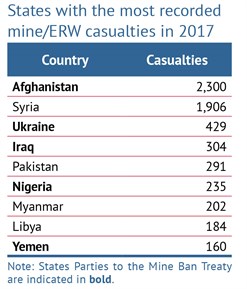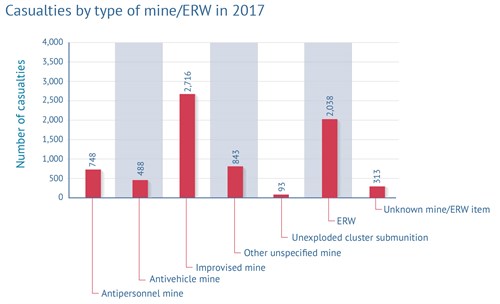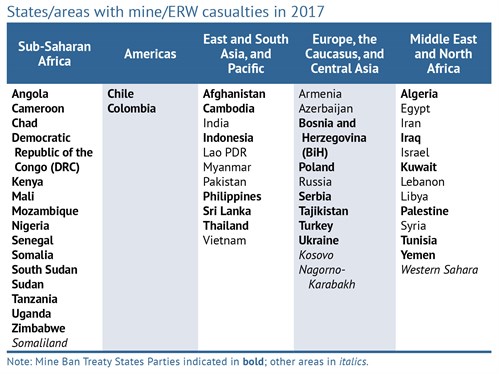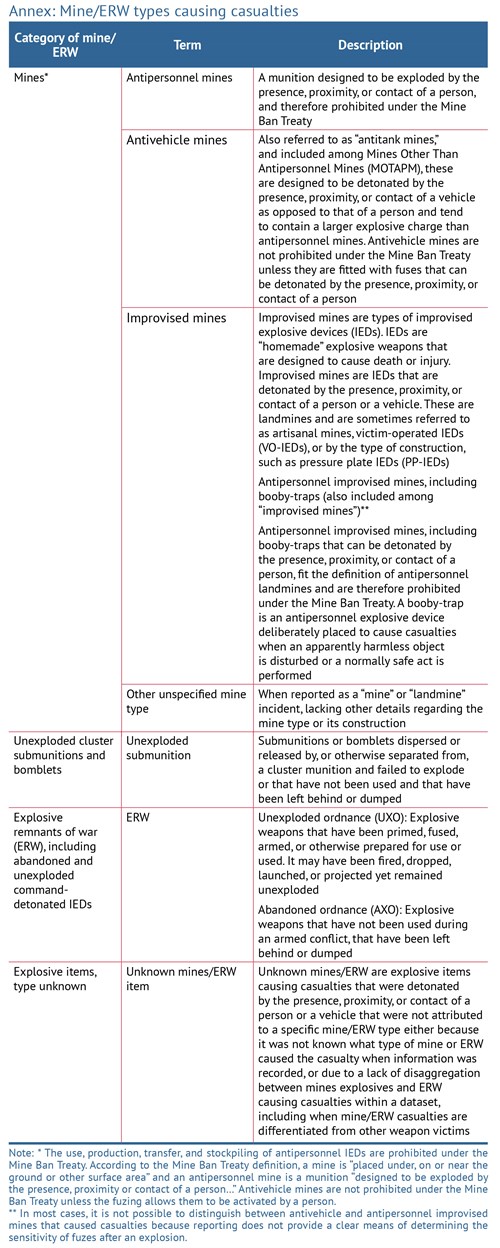Landmine Monitor 2018
Casualties
Overview
High numbers of casualties continued to be recorded in 2017, following the sharp rise in 2015, with a total of at least 7,239 people killed or injured by antipersonnel and antivehicle landmines, including improvised landmines, as well as unexploded cluster submunitions,[1] and other explosive remnants of war (ERW)—henceforth mines/ERW. However, it is certain that numerous casualties went unrecorded. Some of the most mine/ERW-affected countries do not have national casualty surveillance systems in place, nor do other forms of adequate reporting exist.
While remaining very high, the total for 2017 marks a decrease on the casualties recorded for 2016. The casualty database for Landmine Monitor Report 2018 includes an updated total of 9,437 casualties for 2016 (2,472 killed, 6,937 injured, and 28 unknown). At the time of the publication of Landmine Monitor Report 2017, 8,605 casualties had been recorded for 2016 (2,089 killed, 6,491 injured, and 25 unknown).
More than 120,000 casualties have been included in the Landmine Monitor database in the period 1999–2017.
Of the total of 7,239 mine/ERW casualties the Monitor recorded for 2017, at least 2,793 people were killed and another 4,431 people were injured; for 15 casualties it was not known if the person survived or was killed.[2]
For a second year the highest number of annual casualties caused by improvised mines and the most annual disaggregated number of child casualties were recorded.
Civilians represented the vast majority of casualties compared to military and security forces,[3] continuing the well-established trend of civilian harm that influenced the adoption of the Mine Ban Treaty: 87% of casualties were civilians in 2017 where the status was known.
The country with the most recorded casualties in 2017 was State Party Afghanistan, with 2,300, followed by state not party Syria with 1,906 casualties reported. Mine/ERW casualties were identified in a total of 53 states and other areas in 2017.[4] Of the total recorded casualties in 2017, 60% (4,355) occurred in 35 States Parties to the Mine Ban Treaty.[5]
Since the first years of the Mine Ban Treaty, it was certain that many casualties went unrecorded. In 1999, the Monitor identified some 9,000 casualties, but estimates indicated that there were another 7,000–13,000 annual casualties that were not recorded in the available data. From 1999 through 2006 the number of new mine casualties (recorded and estimated) each year was between 15,000 and 20,000. For each year between 2009 and 2014 the Monitor estimated that there have been approximately 1,000 additional casualties (an additional 25–30% of the total) that are not captured in its global mine/ERW casualty statistics. Subsequently, due to the highly irregular accessibility of data for countries experiencing conflict after 2014, estimating the gaps become less viable. However, over time new data for past mine/ERW casualties sometimes becomes available.
The global casualties total since 1999 increases every reporting year, due to new casualties recorded, but also with the updating of historical data with newly available statistics. More than 122,000 casualties have been recorded by the Landmine Monitor just in the period since 1999.[6] For all time, more than 500,000 casualties have been reported for affected states.[7]
Casualty Recording for 2017

The 7,239 mine/ERW casualties identified in 2017 only include recorded casualties, not estimates.[8] It is certain that there are additional casualties each year that are not captured in the Monitor’s global mine/ERW casualty statistics, with most occurring in severely affected countries and those experiencing conflict. In some states and areas, numerous casualties go unrecorded; therefore, the true casualty figure is likely significantly higher in those countries.
The Monitor identified 1,906 mine/ERW casualties in Syria from multiple sources for 2017.[9] However, since the conflict began in 2011, annual recorded totals of mine/ERW casualties are thought to be an undercount. It is certain that the actual number of casualties occurring in Syria in 2017, as in past years, was significantly higher than the annual total recorded.
As in previous years, it is certain that there are many more mine/ERW casualties that occurred in Iraq in 2017 that have not been identified. It is particularly apparent that improvised landmine casualties that occurred in Mosul in 2017 are so far vastly underreported.[10] It was reported that large sections of Mosul were mined and booby-trapped by the non-state armed group Islamic State. In August 2017, the United Nations Mine Action Service (UNMAS) was reported as stating that since clearance operations began in October 2016, some 1,700 people had been killed or injured by such explosive hazards.[11] The 2017 total number of mine/ERW casualties recorded for Iraq was 304, with 124 of that number occurring in Mosul.
The ongoing conflict in Yemen prevented the operation of a national casualty surveillance mechanism. The 160 casualties identified by the Monitor for 2017 is certainly an underreporting of the annual total and is much less than the 2016 total of 2,037.In 2017 and 2018, various Yemeni authorities and human rights organizations reported annual totals and cumulative totals for all time. However, their reports rarely describe the source or methodology used to compile these figures, and in some cases, do not specify the time period. The figures provided differ widely, indicating the challenge of collecting reliable data in a context of ongoing conflict. Thus, no significant quantity of disaggregated annual data was available for Yemen for 2017.
Due to the continuing conflict, the national casualty surveillance system in Libya was not truly functional. The Libyan Mine Action Center (LibMAC) and the UN Support Mission in Libya (UNSMIL) collected information on casualties, but these were not in an integrated database. Furthermore, two key sources for Monitor data in previous years were no longer available. Therefore, the significant decrease to 184 casualties identified in 2017 from the 1,610 casualties reported for 2016 may not be indicative of the nature of a trend or scale.
New information on casualties in Nigeria (235 in 2017) was recorded by Mines Advisory Group (MAG), resulting in an improved understanding of the extent of the impact of improvised mines in that State Party.
Casualty demographics[12]
There were at least 2,452child casualties in 2017. Child casualties in 2017 accounted for 47% of all civilian casualties for whom the age group was known (5,183).[13] Children were killed (773) or injured (1,679) by mines/ERW in 38 countries and other areas in 2017.[14]
As in previous years, in 2017 the vast majority of child casualties where the sex was known were boys (84%).[15]
ERW caused the most child casualties (1,332, or 54% of child casualties). Child casualties made up more than half (48, or 52%) of all casualties caused by unexploded cluster submunitions. (For more information on child casualties and assistance see the annual Monitor publication on landmines/ERW and children.)
In 2017, men and boys made up the vast majority of all casualties, with 87% of all casualties for which the sex was known (4,874 of 5,614). Women and girls made up 13% of all casualties for which the sex was known (740).
Civilians represented 87% of casualties in 2017 where the civilian/military status was known (5,802 of 6,701).
There were 839 military casualties. The country with the most recorded military casualties of mines/ERW in 2017 was Ukraine, with 189; followed by Nigeria, with 151 military and combatant casualties (including militia); and Pakistan with 93 military casualties recorded (including soldiers, militia, and militants).
In 2017, the Monitor identified 60 casualties among deminers in 14 countries (18 deminers were killed and 42 injured).[16]
Mine/ERW types resulting in casualties
In 2017, landmines of all types caused at least 4,795 casualties—these were recorded as being caused by factory-made antipersonnel mines (748), antivehicle mines (488), improvised mines (2,716), and other unspecified mine types (843).
Unexploded submunitions caused 93 casualties and other ERW caused 2,038 casualties.A total of 313 casualties were the result of mine/ERW items that were not disaggregated in data.

Casualties recorded as caused by factory-made antipersonnel mines (thus, not including improvised mines) were documented in 23 states and areas in 2017.[17]
Casualties from improvised mines (not included among casualties recorded as from factory-made antipersonnel mines, antivehicle mines, or other unspecified types of mines)were identified in 18 states in 2017.[18] Most improvised mine casualties in 2017 occurred in Afghanistan (1,093) and Syria (887).
For 16 countries and areas, 862 casualties were recorded under the category of other unspecified mine types.[19] Some three quarters of those casualties were recorded for Syria (1,208, or 74%).
In 2017, antivehicle mines caused at least 488 casualties in 20 states and areas.[20] The states with the greatest numbers of casualties reported from antivehicle mines were Pakistan (132) and Ukraine (103).[21]
Casualties caused by ERW numbered 2,038 in 38 states and areas in 2017. Of the annual total, 1,124 ERW casualties occurred in Afghanistan.[22] In 2017, globally, children made up 69% (1,324) of civilian ERW casualties, when the age group was recorded.[23]
Unknown or undifferentiated mine/ERW items were recorded as the cause of 313 casualties in 16 countries in 2017.[24]


[1] Casualties from unexploded cluster submunitions (unexploded submunitions), which are cluster munition remnants, are included in the Monitor global mine/explosive remnants of war (ERW) casualty data. Casualties occurring during a cluster munition attack are not included in this data; however, they are reported in the annual Cluster Munition Monitor report. For more information on casualties caused by unexploded submunitions for the year 2017, see ICBL-CMC, Cluster Munition Monitor 2018, www.the-monitor.org/en-gb/reports/2018/cluster-munition-monitor-2018.aspx.
[2] As in previous years, there was no substantial data available on the numbers of people indirectly impacted as a result of mine/ERW casualties and this information was not included in the Monitor mine/ERW casualty database.
[3] The category “military” includes police forces and private security forces when active in combat as well as members of non-state armed groups and militias. Direct participation in armed conflict, also called direct participation in hostilities, distinguishes persons who are not civilians in accordance with international humanitarian law, whereby “those involved in the fighting must make a basic distinction between combatants, who may be lawfully attacked, and civilians, who are protected against attack unless and for such time as they directly participate in hostilities.” ICRC, “Direct participation in hostilities: questions & answers,” 2 June 2009, bit.ly/ICRCDirectParticipationFAQ.
[4] In 2017, casualties were recorded in Afghanistan, Algeria, Angola, Armenia, Azerbaijan, Bosnia and Herzegovina (BiH), Cambodia, Cameroon, Chad, Chile, Colombia, Democratic Republic of the Congo (DRC), Egypt, India, Indonesia, Iran, Iraq, Israel, Kenya, Kuwait, Lao PDR, Lebanon, Libya, Mali, Mozambique, Myanmar, Nigeria, Pakistan, Palestine, Philippines, Poland, Russia, Senegal, Serbia, Somalia, South Sudan, Sri Lanka, Sudan, Syria, Tajikistan, Tanzania, Thailand, Tunisia, Turkey, Uganda, Ukraine, Vietnam, Yemen, and Zimbabwe, and four other areas Kosovo, Nagorno-Karabakh, Somaliland, and Western Sahara.
[5] Casualties were identified in the following States Parties in 2017, as well as Palestine and Sri Lanka which were not yet State Parties, but are now: Afghanistan, Algeria, Angola, BiH, Cambodia, Cameroon, Chad, Chile, Colombia, DRC, Indonesia, Iraq, Kenya, Kuwait, Mali, Mozambique, Nigeria, Philippines, Poland, Senegal, Serbia, Somalia, South Sudan, Sudan, Tajikistan, Tanzania, Thailand, Tunisia, Turkey, Uganda, Ukraine, Yemen, and Zimbabwe.
[6] The Monitor database includes 122,288 casualties for the period 1999–2017.
[7] However, cumulative national casualty figures are sometimes multi-annual aggregates or based on extrapolations of survey results and therefore may not be included in the Monitor casualty dataset for the period 1999–2017.
[8] The data collected by the Monitor is the most comprehensive and widely-used annual, and global, dataset of casualties caused by mines/ERW.The casualty total for 2017 included datasets or reporting from the following types of sources: international organizations, UN and national mine action centers, other UN agencies, humanitarian mine action operators, ICBL members, and other NGOs, as well as media scanning.
[9] Not including the occupied Golan Heights.
[10] See, Landmine Monitor 2017 for details on the issues of reporting on improvised mine casualties in Iraq, the-monitor.org/LM17.
[11] Lucy Rodgers, Nassos Stylianou, & Daniel Dunford, “Is anything left of Mosul? The battle to save the city and its people,” BBC News, 9 August 2017, www.bbc.co.uk/news/resources/idt-9d41ef6c-97c9-4953-ba43-284cc62ffdd0.
[12] The Monitor tracks the age, sex, civilian status, and deminer status of mine/ERW casualties to the extent that data is available and disaggregated.
[13] Child casualties are defined as all casualties where the victim is less than 18-years of age at the time of the incident. Child casualties made up 40% of the total recorded casualties.
[14] In 2017, child casualties were recorded in Afghanistan, Algeria, Angola, BiH, Cambodia, Colombia, DRC, India, Iran, Iraq, Israel, Kenya, Kuwait, Lao PDR, Lebanon, Libya, Mali, Mozambique, Myanmar, Nigeria, Pakistan, Palestine, Philippines, Russia, Senegal, Somalia, South Sudan, Sudan, Syria, Tajikistan, Tanzania, Turkey, Uganda, Ukraine, Vietnam, and Yemen, and two other areas, Kosovo and Somaliland.
[15] There were 1,775 boys and 329 girls recorded as casualties in 2017; the sex of 348 child casualties was not recorded.
[16] In 2017, casualties among deminers occurred in Afghanistan, Angola, Cambodia, Chile, Iran, Iraq, Lebanon, Libya, Russia, Serbia, Syria, Thailand, Turkey, and Yemen.
[17] In 2017, antipersonnel mine casualties were recorded in Afghanistan, Algeria, Angola, BiH, Cambodia, Chile, Iraq, Kuwait, Lebanon, Libya, Mozambique, Myanmar, Pakistan, Senegal, South Sudan, Syria, Tajikistan, Turkey, Ukraine, and Yemen, and other areas, Kosovo and Western Sahara.
[18] In 2017, improvised mine casualties were recorded in 17 states: Afghanistan, Algeria, Cameroon, Colombia, India, Iraq, Libya, Mali, Nigeria, Pakistan, Philippines, Syria, Thailand, Tunisia, Turkey, Ukraine, and Yemen. Additionally, improvised mine casualties were known to have occurred in Myanmar, but these are undifferentiated from other mine casualties in data. Among sources used by the Monitor for calendar year 2017 data on improvised mine casualties included data from among the casualties of explosive incidents categorized as “victim-activated” in the Action on Armed Violence (AOAV) explosive violence data set for 2017. AOAV casualty data for 2017 provided by email from Jennifer Dathan, Researcher, AOAV, 29 August 2018; and Monitor analysis of Armed Conflict Location and Event Data project (ACLED) data for calendar year 2017. Approved citation: Clionadh Raleigh, Andrew Linke, Håvard Hegre, and Joakim Karlsen, “Introducing ACLED-Armed Conflict Location and Event Data,” Journal of Peace Research, Issue 47(5), 2010, pp. 651–660..
[19] In 2017, unspecified mine casualties were recorded in Algeria, Armenia, Cameroon, Chad, Iran, Iraq, Lebanon, Libya, Mali, Pakistan, Syria, Thailand, Tunisia, Ukraine, Yemen, and other area Nagorno-Karabakh.
[20] In 2017, casualties from antivehicle mines were identified in the following states: Afghanistan, Angola, Azerbaijan, BiH, Cambodia, Chad, Egypt, Iran, Lebanon, Mali, Myanmar, Pakistan, Russia, South Sudan, Sudan, Syria, Ukraine, Yemen, and other areas, Nagorno-Karabakh and Western Sahara.
[21] The Monitor shares, cross-references, and compares data with the Geneva International Centre for Humanitarian Demining (GICHD) and the Stockholm International Peace Research Institute (SIPRI) Anti-vehicle mines (AVM) project. That project recorded 491 casualties from both confirmed and suspected antivehicle mines in 24 countries in 2016. GICHD-SIPRI casualty data provided by email from Ursign Hofmann, Policy Advisor, GICHD, 22 February 2018. See also, GICHD-SIPRI, “Anti-Vehicle Mines,” undated,www.gichd.org/avm. Monitor and GICHD-SIPRI methodologies used to enter data differ, resulting in the differences in annual casualties reported. For example, Monitor data does not include casualties that occur to persons engaged in laying or emplacing mines. Monitor reporting does include politically disputed geographic “other areas” in reporting, and tends to use the definitions employed in original whole data sets when possible. In some cases, when an incident was attributed to both antivehicle mines and improvised mines in different sources, the Monitor included those as improvised mine casualties.
[22] In 2017, Afghanistan, Algeria, Angola, BiH, Cambodia, Chad, Colombia, DRC, India, Indonesia, Iran, Iraq, Israel, Kenya, Lao PDR, Lebanon, Libya, Mali, Mozambique, Myanmar, Nigeria, Pakistan, Palestine, Philippines, Poland, Russia, Somalia, South Sudan, Sudan, Syria, Tanzania, Turkey, Uganda, Ukraine, Vietnam, and other areas Kosovo, Somaliland, and Western Sahara. In addition to other types of ERW in 2017, casualties of unexploded submunitions were identified in Cambodia, Iraq, Lao PDR, Lebanon, Serbia, Syria, Vietnam, Yemen, and other areas Nagorno-Karabakh, and Western Sahara. For more information on casualties caused by unexploded submunitions and the annual increase in those casualties recorded for the year 2017, see ICBL-CMC, Cluster Munition Monitor 2018.
[23] Of the total ERW casualties in 2016, 586 were adults.
[24] Casualties from unknown mine/ERW items were recorded in: Angola, Azerbaijan, DRC, Lebanon, Libya, Mali, Myanmar, Nigeria, Somalia, South Sudan, Sri Lanka, Sudan, Syria, Thailand, Ukraine, and Yemen.

